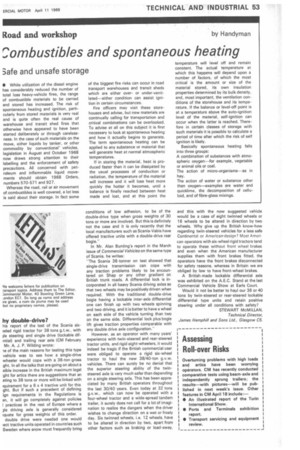ombustibles and spontaneous heating
Page 55

If you've noticed an error in this article please click here to report it so we can fix it.
3afe and unsafe storage
• While utilization of the diesel engine has considerably reduced the number of total loss heavy-vehicle fires, the range of combustible materials to be carried and stored has increased, The risk of spontaneous heating and ignition, particularly from stored materials is very real and is quite often the real cause of warehouse and transit shed fires that otherwise have appeared to have been started deliberately or through carelessness. In the case of such materials on the move, either liquids by tanker, or other commodity by conventional' vehicles, legislation in August and October 1968 now draws strong attention to their labelling and the enforcement of safety precautions. All concerned with petroleum and inflammable liquid movements should obtain 1968 Orders, numbers 570-571 and 927.
Whereas the road, rail or air movement of combustibles is well covered, a lot less is said about their storage. In fact some of the biggest fire risks can occur in road transport warehouses and transit sheds which are either overor under-ventilated—either condition can assist ignition in certain circumstances.
Fire officers may visit these storehouses and advise, but new materials are continually calling for transportation and critical combinations can be overlooked. To advise at all on this subject it is first necessary to look at spontaneous heating and how it actually begins to generate. The term spontaneous heating can be applied to any substance or material that will generate heat at normal atmospheric temperatures.
If in storing the material, heat is produced faster than it can be dissipated by the usual processes of conduction or radiation, the temperature of the material will increase and it will lose heat more quickly the hotter it becomes, until a balance is finally reached between heat made and lost, and at this point the temperature will level off and remain constant. The actual temperature at which this happens will depend upon a number of factors, of which the most critical is the amount or size of the material stored, its own insulation properties determined by its bulk density, and, most important, the ventilation conditions of the storehouse and its temperature. If the balance or level-off point is at a temperature above the auto-ignition level of the material, self-ignition can occur when the latter is reached. Therefore in certain classes of storage with such materials it is possible to calculate a period of time after which the risk of self ignition is likely.
Basically spontaneous heating falls into three groups: A combination of substances with atmospheric oxygen—for example, vegetable or animal oils or coal.
The action of micro-organisms--as in hay.
The action of water or substance other than oxygen—examples are water and quicklime, the decomposition of celluloid, and of fibre-glass mixings.












































































































































